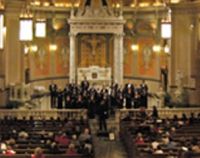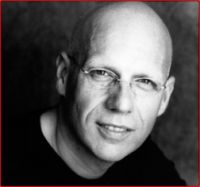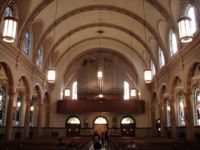Down with the Rosemary and Bays: the New VAE
Mary Ellyn Hutton
Posted: Dec 15, 2009 - 12:33:32 AM in
reviews_2009

The Vocal Arts Ensemble in St. Boniface Church in Cincinnati
|
When Donald Nally, new music director of Cincinnati's Vocal Arts Ensemble, selected the encore for the VAE's annual Christmas concert December 13 at St. Boniface Church in Northside, it wasn't one of the familiar carols that saturate malls, elevators, commercial advertising and seemingly everything this time of year.
Instead, he chose "Lullay, Lullay, Little Child" by Jonathan Varcoe (1990).
As he explained to the audience at the beginning of the concert, "we're going to present what composers of today thought of the 2,000-year-old story."
Then, with the last light of day filtering through the stained glass windows of the handsome, 1927 Romanesque church and the interior lights dimmed, he led the 22-voice choir in John Tavener's "Mother and Child," vintage 2002.
The concert was divided into two parts, “Mother” and “Child.” Eight composers were represented, six of them living, Tavener, James MacMillan, Einojuhani Rautavaara, Bo Holten, Andrew Gant and Benjamin C.S. Boyle. The only "dead white Europeans," both British, were Kenneth Leighton and Herbert Howells, who died in 1988 and 1983, respectively. Boyle, 30, was in the audience for the world premiere of his “Down with the Rosemary,” written for the VAE.
As music director of the all-professional VAE, Nally intends to focus on music of our time, which should not cause a problem for anyone, he told Express Cincinnati in October, since “new music today draws on the entire palette of music history.”

Donald Nally
|
The choice of Tavener to open the concert underscored his point symbolically, since Tavener is directly descended from the great 16th-century English composer John Taverner.
Tavener (without the "r") is perhaps best known for his “Song for Athene,” written for the funeral of Princess Diana. He is a convert to Russian Orthodoxy with a deep interest in Eastern philosophy. “Mother and Child" celebrates eternal spirit, “the same in every religious tradition,” writes Tavener in his program note, through Mary as mother, Sophia, the Greek goddess of wisdom, and the Hindu “Atma,” or world soul, the "supreme Reality from which all souls derive.

Nave of St. Boniface Church with view of the organ facade
|
The 22-voice choir sang from the organ loft behind the audience to achieve a closer blend with the church’s fine pipe organ. The effect was warm and enveloping, with just the right amount of reverberation.
The music grew from hushed and tender to blocks of chords by the organ and choir, to a hair-raising climax on “Atma” accompanied by strokes of Hindu Temple Gong by Chris Barrick from the front of the sanctuary.
Kenneth Leighton’s “Hymn to the Nativity” (1960) for soprano soloist and choir contrasted an image of the sleeping child, with the jubilant arrival of the shepherds. Scotsman James MacMillan’s 1996 “Seinte Mari moder milde” (“Holy Mary, mother mild”) written for the Service of Advent Lessons and Carols at King’s College Cambridge, was vivid and dramatic. It began with alternating soprano and bass lines and rumbles in the organ. A tenor solo rang out against prickly harmonies and considerable ornamentation by the voices, leading to a sudden fortissimo on”Pecantis” (“as I pray”) followed by soft fragments to the end.
Some of the most beautiful music on the program was by Finnish composer Rautavaara, whose a capella (unaccompanied) “Canticum Mariae virginis” (1978) was sung at the front of the church. It interweaves three texts about Mary, “Ave maris stella” (“Hail, star of the sea”), “Gaude maria virgo” (“Rejoice, Virgin Mary”), and “Beatam dicent omnes generations” (“All generations will call me blessed”) with the voices exchanging pitches for a shimmering tonal effect. Its cascading structure, designed to come together in a cosmic unity at the end, reminded this listener of Estonian Arvo Pärt’s “Fratres."
The choir remained at the front of the church after intermission with Danish composer Bo Holten’s a capella “First Snow” (1996). After a false start, for which Nally good-humoredly apologized, he led the singers in a marvelous musical portrait of snow falling softly, turning into a noisy blizzard, then ending de-crescendo “grim and cold.” The second image, “Hermit Peak,” of a mountain standing solid against the squall, was loud and angry, with a big dissonant chord on “granite” (the last word), as if the force of the storm was shattered against its unyielding surface.
The choir returned to the organ loft for the remainder of part II ("Child"). Andrew Gant’s “What child is this,” originally for men’s voices and arranged for The Crossing (Nally's Philadelphia Choir) in 2007, was the most “popular” sounding work on the program. It had a romantic, almost Broadway sound, with lilting, dotted rhythms and a final, solidly satisfying major chord.
“Tryste Noel” (1977) by Herbert Howells about the newborn child in the ox’s stall exuded Anglican High Church majesty, ending on an unresolved chord, as if hinting at the mystery of the Incarnation. (Howell's work, set to a poem by Louise Imogen Guiney in an 1892 issue of Harper’s Magazine, was included on “Spotless Rose,” winner of the 2008 Grammy for Best Small Ensemble Recording.)

Benjamin C.S. Boyle
|
Boyle’s world premiere was preceded by two of his other “Carols for Wintertide,” fruits of a continuing collaboration with Nally.
“Es ist ein Ros” (2007), a setting of the 15th-century German carol “Lo, How a Rose e’er blooming,” came closest to “familiar” of the selections heard on the program. The organ -- played with sensitivity and skill by the VAE’s Christina Haan -- had an equal role in counterpoint with the singers.
“The Holly and the Ivy,” a free adaptation of the medieval English carol, was written a capella for the chorus of Lyric Opera of Chicago, which Nally also heads. The VAE sang it sweetly indeed, with an exuberant up sweep on “sweet” that suggested a great big lick on an over-sized lollipop.
Nothing could have been more appropriate to usher in Nally’s new regime than Boyle's “Down with rosemary,” which refers to an old English custom of leaving the Christmas greens up until the Eve of Candlemas (February 1, after Twelfth Night), when they were removed to usher in the new year. Apparently the text, by 17th-century poet Robert Herrick, includes the first mention of mistletoe as a Christmas evergreen. This may be the reason (?) Boyle highlighted the word “mistletoe” with a flourish of flutes on the organ. The work as a whole had a delightfully “antiqued” sound.
Final selection was Leighton’s 1962 anthem “O Leave Your Sheep,” three-minute version of an old French carol, with verses treated canonically, and a joyous, fortissimo salute to the arrival of the Three Kings.
After the encore, there was a reception in the narthex of the church, where Nally met members of the audience and answered questions about the “new” VAE. Present was former VAE music director Earl Rivers, who blazed the way for Nally during his distinguished 20-year tenure, that included commissioning new works, two VAE CDs, two ASCAP Awards for Innovative Programming and a Post-Corbett Award for Lifetime Achievement in the Arts.
The next VAE concert is April 10 at the Contemporary Arts Center.





